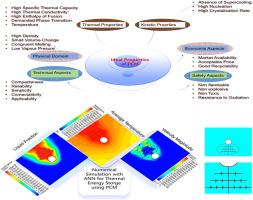利用纳米颗粒和新型翅片结构热增强相变材料
IF 7.9
3区 材料科学
Q1 GREEN & SUSTAINABLE SCIENCE & TECHNOLOGY
引用次数: 0
摘要
相变材料(PCMs)由于其显著的能量密度和维持稳定温度的能力,已被证明在热能储存系统中至关重要。本研究探讨了在矩形外壳内添加Fe3O4−Cu杂化纳米颗粒的熔盐基纳米增强相变材料(NEPCM)中,在下部添加新的树枝状鳍结构如何改善传热和熔化动力学。一个没有鳍的基线例子,第二个有树枝状鳍的情况下,分支长度向底部减少(类型1),第三个有树枝状鳍的情况下,分支长度向底部增加(类型2),这是本研究中检查的三种不同的配置。采用孔隙率-焓法对其热行为进行了数值模拟。我们还开发了一个具有多层感知器架构的人工神经网络(ANN)模型,该模型包括两个隐藏层,用于预测熔化特性和热性能参数,并在计算和实验数据集上对其进行训练。当与混合纳米粒子配对时,总熔化速度提高了约41%。在所有测试设置下,相关系数大于0.98,平均相对误差小于3.5%,所建立的人工神经网络模型能够预测熔化率、平均温度和努塞尔数。神经网络模型的灵敏度分析表明,纳米颗粒的浓度和翅支长度比是影响热性能的两个最重要的因素。对于未来的研究,将有利于重点优化这些树枝状鳍结构的参数,并研究理想的Fe3O4−Cu比,以实现最大的热性能,同时确保胶体稳定性。本文章由计算机程序翻译,如有差异,请以英文原文为准。

Thermal enhancement of phase change materials using nanoparticles and novel finned structures
Phase change materials (PCMs) have proven vital in thermal energy storage systems due to their remarkable energy density and capacity to sustain a stable temperature. This study examines how adding new dendritic fin structures positioned in the lower region can improve heat transfer and melting kinetics in a molten salt-based nano-enhanced phase change material (NEPCM) with hybrid nanoparticles inside rectangular enclosures. A baseline example without fins, a second case with dendritic fins whose branch lengths decrease toward the bottom (type 1), and a third case with dendritic fins whose branch lengths increase toward the bottom (type 2) are the three different configurations that are examined in this study. The thermal behavior was numerically modelled using the porosity-enthalpy method. We also developed an artificial neural network (ANN) model with a multilayer perceptron architecture that includes two hidden layers to predict melting characteristics and thermal performance parameters, training it on both computational and experimental datasets. When paired with hybrid nanoparticles, total melting was accomplished about 41 % faster. With correlation coefficients above 0.98 and mean relative error below 3.5 % under all test settings, the created ANN model was able to predict melting percent, average temperature, and Nusselt number. The ANN model's sensitivity analysis revealed that the two most important factors influencing thermal performance were the concentration of nanoparticles and the fin branch length ratio. For future studies, it would be beneficial to focus on optimizing the parameters of these dendritic fin structures and to investigate the ideal ratios to achieve maximum thermal performance while ensuring colloidal stability.
求助全文
通过发布文献求助,成功后即可免费获取论文全文。
去求助
来源期刊

Materials Today Sustainability
Multiple-
CiteScore
5.80
自引率
6.40%
发文量
174
审稿时长
32 days
期刊介绍:
Materials Today Sustainability is a multi-disciplinary journal covering all aspects of sustainability through materials science.
With a rapidly increasing population with growing demands, materials science has emerged as a critical discipline toward protecting of the environment and ensuring the long term survival of future generations.
 求助内容:
求助内容: 应助结果提醒方式:
应助结果提醒方式:


